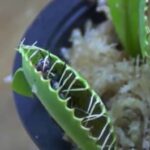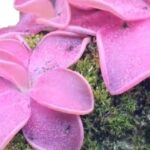As an Amazon Associate, this site earns commissions from qualifying purchases. For more details, click here.
Watching sundews trap and eat insects can be fascinating and it is the reason why it is a very popular carnivorous plant. Insects provide nutrients for the plant, but is there such a thing as overfeeding? Could you end up giving your sundews too much nutrient? If you are new to these plants or want to buy one right now, knowing how much to feed them is a must.
Sundews only need to eat 2 to 4 times a month. Overfeeding forces sundews to use a lot of energy to trap and eat, and over time this weakens the plant and it becomes unresponsive to prey.
Symptoms of Overfed Sundews
An overfed drosera will not eat any prey caught in its trap. The plant is not going to release a trapped insect, but will not eat it either. You will see the bug stuck in its mucilage (commonly called dew), trying to escape.
Usually its tentacles will roll over a trapped bug, but overfed sundews do not have enough energy to do that. Eventually the insect will die and rot. The decay spreads to the tentacle which will die as well.
Another sign is unresponsiveness. Drop an insect into the leaf and see what happens. A hungry drosera will hurl the insect into other tentacles so it can be digested. Overfed sundews lack the resources to do this continuously. It needs time to fully digest its current meal before proceeding to the next one.
How to Feed Sundews Step by Step
Adult sundews should be fed at least once or twice a month. Some variants can eat up to four times. The plant responsiveness and health are the best gauges on whether you are overfeeding it or not.
The easiest way to feed a sundew is to just drop the food into the sticky substance. However there are other things you may want to consider.
- Decide what food to give your sundew. Almost any small insect will do, or you can give it worms such as Amzey Store Dried Mealworms.
- Use a grinder rolling pin or something heavy to crush the food into powdery bits.
- Get a cup and mix the powdered food with water at a 1:1 ratio. Use a syringe to add the water droplets.
- Use an eyedropper or tweezers to drop the food into one of the sundews leaves.
Sundews can only eat small insects like spiders, aphids and gnats. If you want to feed something larger, crush the bug into smaller pieces. This also applies to non-living food like fish flakes or freeze dried worms. Crush them into small bits and feed only a small amount to the plant.
You can feed sundews once a week for faster growth. There is little risk of overfeeding especially if the plant is of the larger variant and healthy. Fully mature sundews can survive with twice yearly feeding, but for best results, feed two to four times a month.
Some things to keep in mind.
- The larger the sundews, the more food it can eat. If your sundews are small, wait for it to grow before feeding more. Otherwise you risk overfeeding the plant.
- Do not allow food bits to drop into the soil. This could cause mold to build up and damage the plant. You can avoid this by proper feeding.
- Large sundews- especially if outdoors – can eat more food. Aside from those mentioned above, fish flakes will do nicely. Drop the flakes onto the tentacles for the best results.
- Fish food is easier to prepare than other sundew foods, so it is probably the best for beginners.
- Be patient when feeding sundews. Some tentacles take half an hour before they roll over the food, but others are much quicker. You can compare sundew trapping and eating speeds in this guide.
What are the Best Foods For Sundews?
You can feed the following to your sundews, provided you do so in small amounts. Strictly speaking these are not food but nutrients for sundews. But we are using the term food here for simplicity.
- Spiders, ants, flies, crickets, fungus gnats and wasps (cut the insects into smaller bits first)
- Freeze dried bloodworms or mealworms
- Betta fish food pellets like those by Zoo Med Micro
You can you also mix any of the above to give your sundews some variety. You can grind mealworms and beta pellets together for example. You can even use other types of fish food as long as they are in small amounts. Fish food is also suitable for Venus flytraps.
What Foods Should I Avoid Giving to Sundews?
Under no circumstances should you give these to your sundews. These can be very harmful and even kill the plant.
- Fertilizer. Rich fertilized soil used in regular potting is not good for sundews and carnivorous plants in general.
- Human food like steak, hamburger, cheese, sausages etc. These are too big and even if you cut them into tiny pieces will not provide any sustenance for sundews.
- Any food that is too large to the plant. This will use up a lot of energy and could weaken your sundews. This could even kill the tentacle that is trying to consume the food.
Do I Need to Feed My Sundews at All?
If your sundews are outdoors, it should be able to catch insects without help. If the plant looks healthy, there is no need to feed it. But if the plant is indoors or not getting enough nutrients, you can feed it by hand.
Adult sundews outdoors will probably be fine. However smaller ones may need help with feeding. When they reach maturity it should be able to catch insects on its own.
Whether or not you should feed it depends on the variant. D intermedia will stop growing and become smaller without nutrients, so do not worry about overfeeding. D filiformis, D hartemeyrorum, D indica, D glanduligera and D burmannii must be fed regularly to grow. These variants might even die without nutrients.
To keep it simple: if your sundew is outdoors and catches bugs regularly, you do not need to give it any insect food. If the plant is indoors with limited access to prey, give it live or dead bugs, fish food or freeze fried mealworms.
Feed your sundews if it is not growing as fast at it should or looks sick. Do this even if it is outdoors. Also make certain the plant receives plenty of light, water and is in nutrition free soil, like sphagnum moss and silica sand.
Tips to Avoid Overfeeding Sundews
The traditional way of feeding sundews is one leaf per week. However you can also feed four leaves at a time, but the next feeding has to be for the following month. It is up to you.
If you feed several leaves simultaneously, do not be surprised if the plant loses some of its color. That is normal as the plant is growing rapidly. You can feed the dew again when its original color comes back.
Food size is very important for young sundews. You have to be careful not to overfeed as this could damage its leaves. As long as they get sufficient sunlight, even small bits of insect food will go a long way.
With adult sundews you can give them more without taxing their resources. This is particularly true with fish flakes. For healthy sundews you just need to grab a bit and drop it on the leaves.
You do not want to spray flakes all over the plant, just a few bits on the leaf. Again you have to be careful and make sure none of this goes into the soil.
With fish pellets you need to mix it with water. This will soften the pellet up and make it easier for sundews to digest. A few small bits is all that is required to satisfy most sundew.
How many pellets? Just one will do. Mix with water until it liquefies and drop it on the leaf. The sundew will do the rest.
Sundews will eat dead bugs without any special preparation. With Venus flytraps you have to tap the hair triggers to get the trap to close. With sundews, you just drop the bug into the sticky material and the plant will start to eat. So feeding is straightforward.
Conclusion
One of the things a new drosera owner has to learn is balance. Strike a balance between not giving it enough and too much. Hopefully the information in this guide was able to provide you with a clear understanding of how sundews should be fed.

My fascination with carnivorous plants began many, many years ago with Venus Fly Traps. Now I am more than happy to impart what I know with other enthusiasts and those who are curious about meat eating plants.



